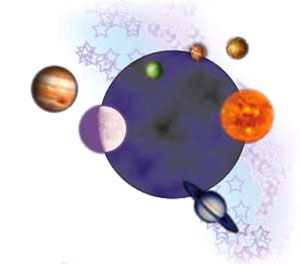Paid Services
Western Astrology & Vedic Astrology: Which System is Better?
Author: S N Rao | Last Updated: Tue 16 Jul 2013 4:15:19 PM

By S. N. Rao
Revelation on the Dilemma of Different Systems of Astrology
There are two different Zodiacal systems which are used in Astrology. Western Astrology uses Sayana type Zodiac (Tropical Zodiac) and the Vedic Astrology uses Nirayana type Zodiac (Sidereal Zodiac). Since there are two different systems being used confusion naturally arises as to which is to be used.
Some astrologers may consider one to be the true zodiac, the other to be in error. Some may consider both to be valid but to different degrees. Some may try to use both together. If we are unbiased, I believe that we can find examples of accurate astrological readings using either of these systems. This may depend more upon the practitioner than the system. Some say that the Tropical system is for westerners, as it was developed there, and that the Sidereal system is for Indians, as it originated from here. The method to predict is different in both the systems and Vedic astrology can give good and accurate readings even for westerners who believe in the Tropical system. Western astrologers can make sense of the Vedic Charts.
Meaning of Ayanamsa
When a Western astrologer says that the Sun is in Aries, he does not mean that the Sun is in the fixed stars of the constellation Aries. He means that it is in the First of a twelvefold division of the zodiac based upon the position of the Sun at the vernal equinox which is usually around March 21st. Similarly, when a Vedic astrologer says that the Sun is in Aries, he means the fixed stars, not the tropical division. The Sun usually enters the fixed star Ashwini around April 14th.Though both astrologers use the same terms, they refer them to different portions of the sky based upon two different ways of dividing the sky. The difference of approximately 23-24 days / degrees between the two systems is termed as Ayanamsa.
Importance of understanding the two Zodiacs
As Vedic astrology is sidereal and based on fixed stars, this means that the signs will change in the Vedic chart from what we find in the Western chart. A person with Taurus Sun sign in Western chart may find their Sun in Aries in the Vedic system. This shift of positions naturally causes some confusion, particularly for those who are not so familiar with Astrology. Hence it is crucial that we understand the two zodiacs and their differences so that we don't confuse one system with the other or try to judge one according to the standards of the other.
To understand this concept we have to visualize the motion of Earths path around the sun. There are a number of fixed stars which the sages have named (Ashwini, Bharani Revati). These constellations are called the Nakshatras and for all practical purposes it may be said that they occupy permanent or fixed positions in the sky. This circle is divided into twelve sections and starts with the first degree of Aries when the Sun crosses the vernal equinox (at equator). Due to the wobbling motion of the earth at the poles the sun does not cross the equator at the same time every year, but it shifts backwards at the rate of about 50.1 seconds per annum, 1 degree in 72 years, 1 sign in 2156 years, completing the circle of 12 signs in about 25,868 years. This backward movement is called "precession of the equinox."
The Sidereal zodiac (Vedic System) is probably the original zodiac historically. The zodiac was invented long before the time when the vernal equinox was in Aries (i.e about 2000 years ago when the sun entered Ashwini Nakshatra). It must have originally been based upon direct observation of the stars. When the sages spoke of the sign Aries, it must have been the fixed star (Nakshatra).
Origin of Astrology
Astrology came originally from India and its astrology has remained fixed throughout its long history. Ancient cultures within us, which maintained the continuity of their civilizations over thousands of years, would quite naturally have to reckon with the precession of the zodiac. This is why the ayanamsa is deducted from the Western chart to determine the positions in the Vedic chart.
Wonders and accuracy of the Systems of Astrology
You may also like to read:
 Best quality gemstones with assurance of AstroCAMP.com More
Best quality gemstones with assurance of AstroCAMP.com More
 Take advantage of Yantra with assurance of AstroCAMP.com More
Take advantage of Yantra with assurance of AstroCAMP.com More
 Yantra to pacify planets and have a happy life .. get from AstroCAMP.com More
Yantra to pacify planets and have a happy life .. get from AstroCAMP.com More
 Best quality Rudraksh with assurance of AstroCAMP.com More
Best quality Rudraksh with assurance of AstroCAMP.com More
Get your personalised horoscope based on your sign.



















